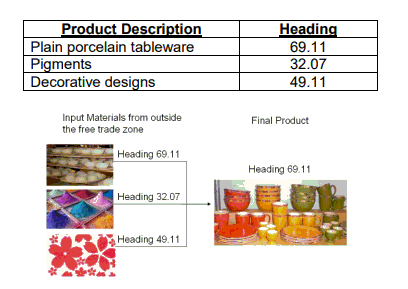The change of tariff classification criterion(CTC) is found in virtually all
origin systems. This criterion may be applied together with other criteria
such as an ad-valorem.
Most systems make wide use of the criterion of change in tariff classification.
Example : Manufacture, in a contracting party of a free trade agreement,
of porcelain tableware decorated in several colors, of tariff heading 69.11,
using the following materials from countries outside the free trade area:

Retrieved from:WCO ORIGIN COMPENDIUM
Given the use of plain tableware which is classified in the same tariff heading as
the final decorated tableware, the working carried out in the contracting party to
the free trade area does not fulfil the product specific rules based on a
change of tariff classification, and the decorated tableware therefore cannot be
considered as originating in the free trade area.
The criterion based on tariff classification changes is considered to have the following
specific features:
Features of the Change in Tariff Classification Criterion:
- Synergy effects can be gained by using the Harmonized System for origin determination,
as most goods in international trade are classified in the
Harmonized System Nomenclature; - The Harmonized System is designed to be a multi-purpose nomenclature and has been
established as a common Customs language; traders and Customs officers are familiar
with the Harmonized System; - Product specific rules based on a change in tariff classification criterion are
unambiguous and simple to apply and control, with a correct classification
of the input materials and the final product; - They can normally be used across-the-board for all product categories,
with specific adaptations of the rules (change of tariff subheading or split-heading
or split-subheading) under certain circumstances; - Once created, product specific rules based on a change of tariff classification
are predictable; - Although the Harmonized System is a multi-purpose nomenclature,
it is not always structured in a suitable way for origin determination purposes; - In some Chapters extensive knowledge on the Harmonized System is needed;
- The Harmonized System is amended every five years which requires a transposition
of the rules of origin (as explained in Section 5); - The application of product specific rules based on a change in tariff classification
may require additional provisions, such as minimal operations/insufficient working
or processing operations.
